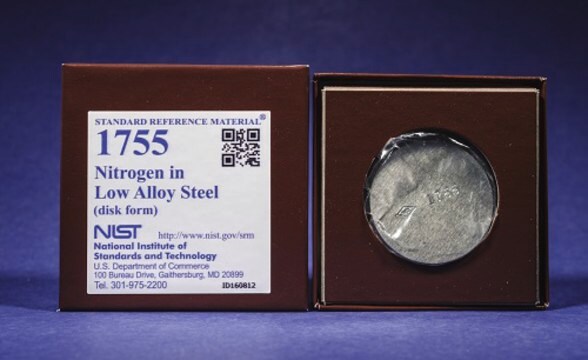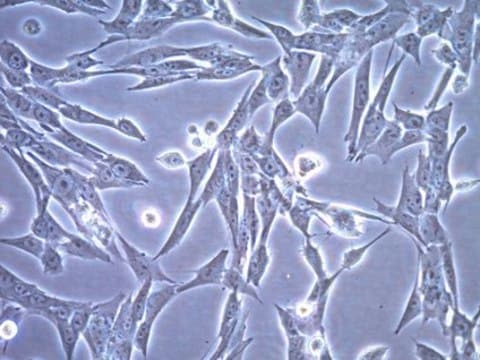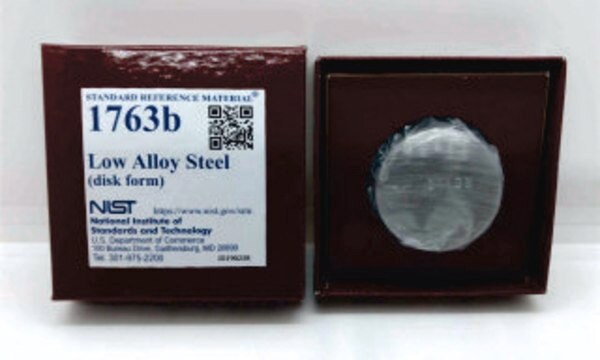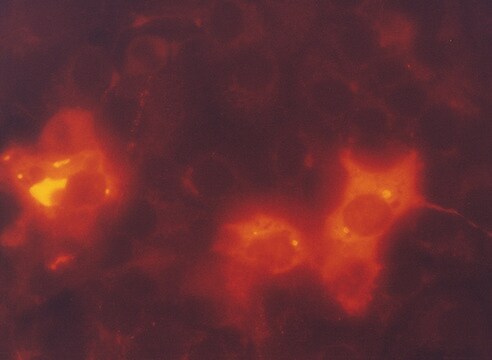SCC416
Py2T Mouse Mammary Tumor Cell Line
Mouse
Sinonimo/i:
Py2T cell line;Mouse mammary tumor cell line;Py2T Murine breast cancer cells
About This Item
Prodotti consigliati
Nome del prodotto
Py2T Mouse Mammary Tumor Cell Line,
Origine biologica
mouse
Livello qualitativo
Confezionamento
vial of ≥1X10⁶ cells
Produttore/marchio commerciale
Millipore
Modalità di accrescimento
N/A
tecniche
cell based assay: suitable
cell culture | mammalian: suitable
Condizioni di spedizione
liquid nitrogen
Temperatura di conservazione
−196°C
Descrizione generale
Applicazioni
- Each vial contains > 1X106 viable cells.
- Cells are tested negative for infectious diseases by a Mouse Essential CLEAR Panel by Charles River Animal Diagnostic Services.
- Cells are verified to be of mouse origin and negative for interspecies contamination from human, rat, Chinese hamster, Golden Syrian hamster, and nonhuman primate (NHP) as assessed by a Contamination Clear panel by Charles River Animal Diagnostic Services
- Cells are negative for mycoplasma contamination.
These cells have a uniform cobblestone-like morphology, typical of differentiated epithelial cells, and express estrogen receptor (ER), and both basal (CK14) and luminal (CK8/18) markers. When these cells are implanted orthotopically in syngeneic FVB/N mice, they form non-metastatic invasive tumors with low or absent E-cadherin.
Epithelial-mesenchymal transition (EMT) is a process involved in the initiation of the invasion-metastasis cascade of cancer cells. 90% of breast cancer-related deaths are ascribed to systemic dissemination of cancer cells leading to their metastatic outgrowth in distant organs.
Source
The Py2T cell line was derived from a mammary tumor of a MMTV-PyMT transgenic mouse.
References
1.PLoS One 2012; 7(11):e48651. PMID: 23144919.
2.Oncogene 2015; 34(32):4190-4198. PMID: 25362852.
3.Sci Rep 2018; 8(1):12123. PMID: 30108334.
4.Ayse NK. University of Basel 2017; Dissertation. https://edoc.unibas.ch/59030/1/Ph.D.%20Dissertation.pdf
Caratteristiche e vantaggi
Stoccaggio e stabilità
Altre note
Esclusione di responsabilità
Codice della classe di stoccaggio
10 - Combustible liquids
Classe di pericolosità dell'acqua (WGK)
WGK 3
Punto d’infiammabilità (°F)
Not applicable
Punto d’infiammabilità (°C)
Not applicable
Certificati d'analisi (COA)
Cerca il Certificati d'analisi (COA) digitando il numero di lotto/batch corrispondente. I numeri di lotto o di batch sono stampati sull'etichetta dei prodotti dopo la parola ‘Lotto’ o ‘Batch’.
Possiedi già questo prodotto?
I documenti relativi ai prodotti acquistati recentemente sono disponibili nell’Archivio dei documenti.
Il team dei nostri ricercatori vanta grande esperienza in tutte le aree della ricerca quali Life Science, scienza dei materiali, sintesi chimica, cromatografia, discipline analitiche, ecc..
Contatta l'Assistenza Tecnica.








